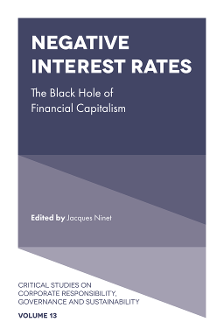
Who Will Save the Central Banks?
ISBN: 978-1-83982-377-0, eISBN: 978-1-83982-376-3
ISSN: 2043-9059
Publication date: 26 November 2020
Citation
Ninet, J. (2020), "Who Will Save the Central Banks?", Negative Interest Rates (Critical Studies on Corporate Responsibility, Governance and Sustainability, Vol. 13), Emerald Publishing Limited, Leeds, pp. 117-118. https://doi.org/10.1108/S2043-905920200000013022
Publisher
:Emerald Publishing Limited
Copyright © 2021 Emerald Publishing Limited.
Note to the Reader
Unlike the first three parts of this book, this last part is not solely the translation of the original 2016/early 2017 manuscript. It has been extensively re-written to take account of the events that occurred through the end of 2019, in particular the unbelievable flip-flop by the Federal Reserve that made the Black Hole Theory permanently relevant.
However, it has not been updated in light of the Covid-19 pandemic and its unpredictable consequences on the economy and finance. However, this dramatic but unforeseen event might rank first among the exogenous accidents mentioned as possible triggers of the next crisis.
Introduction – Unconventional Monetary Policies. Wonder Drug or Iatrogenic Treatment?
Notwithstanding the undisputed broadening of research into the origins of the crisis, the emphasis on purely monetary remedies is hard to kill. Like the G-16 document, you might blame this obstinacy on the humiliation that an official acknowledgment of a collective diagnostic error which led to such dramatic consequences might entail. In the same vein, staying the course keeps current officeholders from endangering the much-vaunted credibility of the institutions they lead. However, these technical/tactical talking points hide the real reason behind such obstinacy, which is the categorical refusal to consider the disqualification of work and the distortions it created for world trade as the principal causes of the crisis. Even if the reason was to thwart public recognition of this inconvenient truth, it all comes down to the same thing.
Seen through the lens of transnational corporations and the people with financial capital, globalization was a unique opportunity to divert the huge gains from the arrival on the labor market of hundreds of millions of very low paid workers with little or no social protections to their coffers. As improvements in productivity began declining, international capitalism found a way to dramatically increase its profits in the offshoring of the production of goods consumed in the West. Walmart Inc., the leader in mass retail, is the best illustration of this system. According to various estimates, this US giant imports 50 billion dollars' worth of products manufactured in China every year or about 25% of its domestic sales.
A creator of large imbalances, this system began stumbling as soon as it started (the crisis of 1997) before drowning in the excessive debt of northern countries, which once had been considered advanced but were now struggling to preserve their standard of living and their social cohesion.
Although outlawed by liberal dogma, the monetization of debt became the main remedy (and the only remedy in Europe after the proclamation of austerity) for curing this outbreak of acute fever. This strategy, designed to be only temporary, certainly met its first objective: restoring the global financial system. But it solved none of the real issues. Its most visible result was driving the price of financial assets to levels unsustainable with the actual state of the economy. While the record for unconventional policies is mixed, their long-term implications are frankly negative. The dreaded question of an exit strategy has raised its head 1 and then suddenly disappeared, in front of its painful consequences, especially since unconventional monetary policies had been implemented for so long.
From Ben Bernanke's first declarations of intent (October 2013) until being permanently abandoned by Jerome Powell (January 2019), the normalization of US monetary policy constantly fluctuated between reason and firmness, on one hand, and hesitation and acquiescence (to the market) on the other. The ultimate abandonment, recognition of failure and/or admission of powerlessness, inevitably leads to the possibility of a dramatic conclusion to the era of negative or zero interest rates.
Zero Interest-rate Policy (ZIRP) and Quantitative Easing (QE)
Central banks have two channels available for implementing monetary policy: the qualitative channel of key interest rates, which determines the cost of refinancing for commercial banks, and the quantitative easing channel through which reserve accounts of these banks are replenished by buying the assets they hold from them. The extraordinary support measures provided by central banks in the aftermath of the 2008 crisis first took the form of zero interest-rate policy, or ZIRP, which was introduced by Japan in the 2000s, followed by QE (purchase of bank assets on a massive scale).
See Blinder et al. (2013).
- Prelims
- Introduction
- Part 1 Financial Capitalism: From the Neoliberal Revolution to the Multifaceted Crisis of the Twenty-first Century
- The Great Turn
- Neoliberalism and the Revenge of Rentier Capitalists
- The Underpinnings of Hyper-Financialization
- The Poor Economic and Financial Record of Thirty-five Years of Neoliberalism
- Part 2 Anatomy of a Crisis
- The Single Crisis of the Asset-based Economy
- A Foreseeable but Not Foreseen Crisis
- Deficit and Debt Trap
- A Useless Crisis?
- Part 3 In the Hands of Central Banks
- Central Bank: A Standard Reading
- Some Facts about the Monetary Economy … To Better Understand the True Role of Central Banks
- The Short History of Central Banks in the Long History of Money
- Theoretical Foundations of Central Banking: From Monetarism to Dynamic Stochastic General Equilibrium (DSGE) Models
- Does Independence Guarantee Infallibility?
- Are Central Bankers Truly Independent?
- An Astonishing Confession
- Part 4 Who Will Save the Central Banks?
- The Black Hole
- Economic and Financial Consequences of NIRP and ZIRP
- TINA (There is No Alternative)?
- Central Banks: At the Core of the Next Confidence Crisis
- Conclusion
- Afterword
- Appendices
- References
- Index of Names